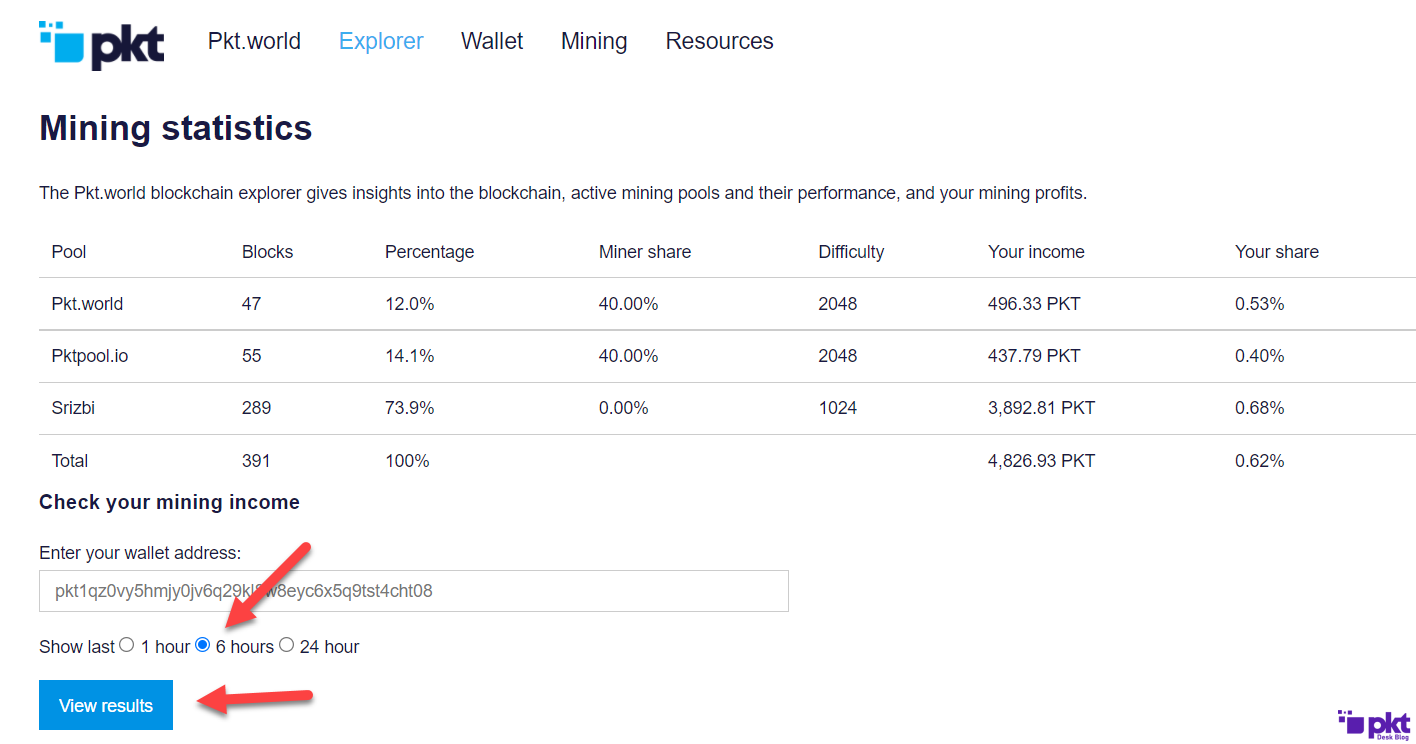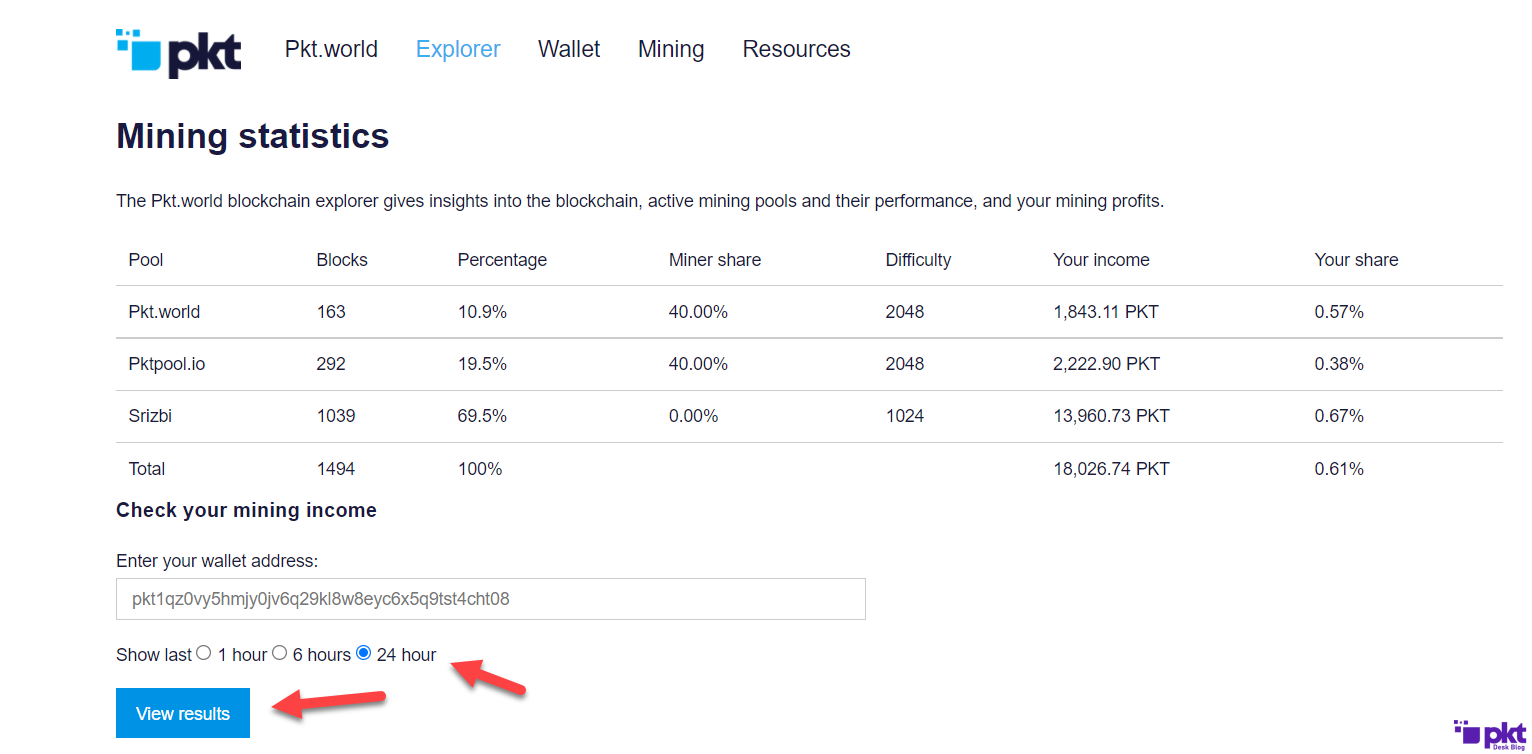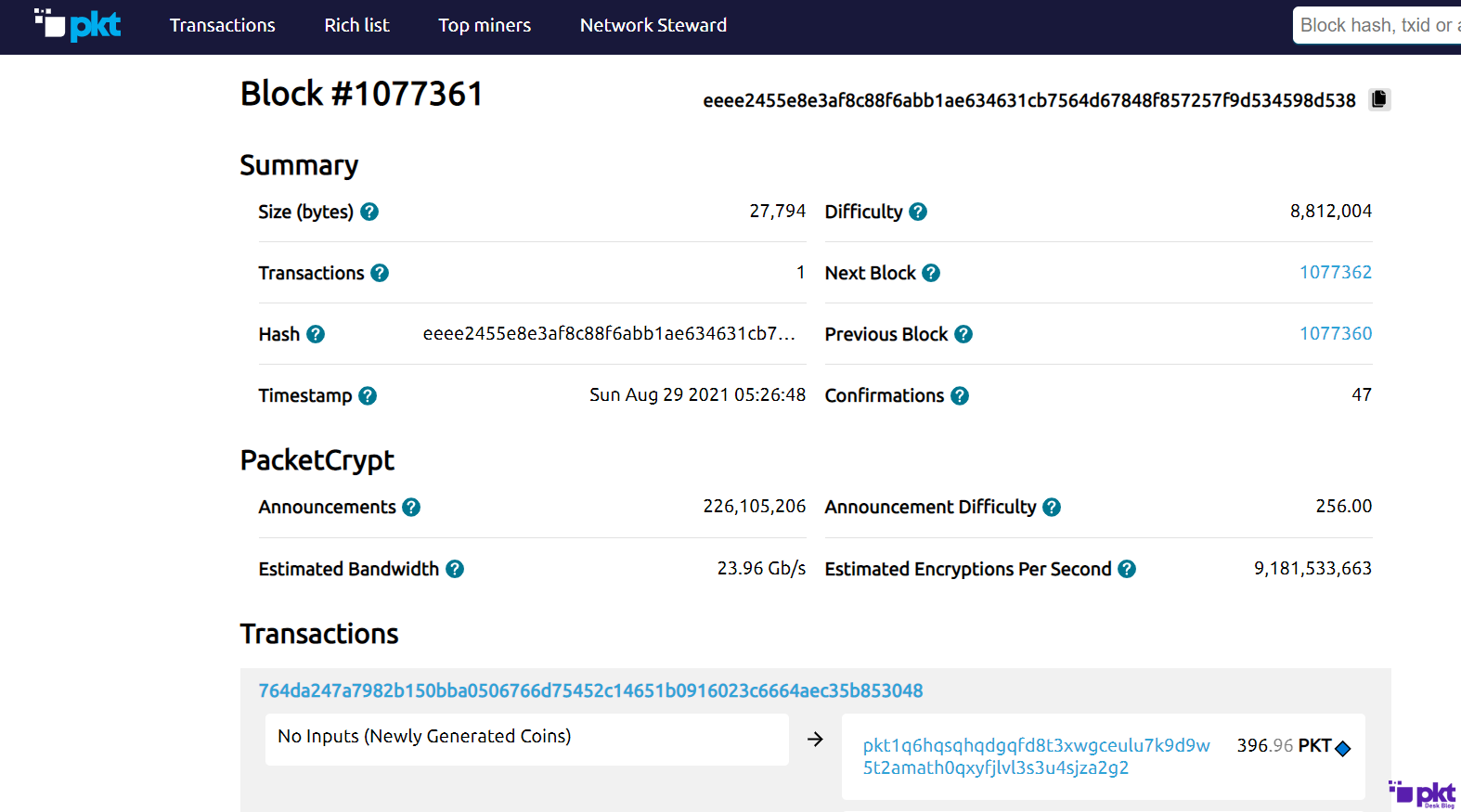Do you want to check your PKT mining rewards? You’ve come to the right place.
PKT is an innovative idea for eradicating monopolies in ISPs all over the world. It’s the world’s first bandwidth-hard blockchain.
Recommended: What is Ke/s in PKT Mining?
You must already be mining PKT, so without wasting time let’s begin.
Check 1 Hour PKT Mining Reward
By combining the power of all the pools, approximately 60 blocks are mined in an hour. As of the time of writing this article, the current block reward is 1992 PKT.
How to get started?
You can view the results by entering your PKT wallet address into the box and clicking “view results.”

Check 6 Hours PKT Mining Reward:
In 6 hours, 360 blocks had to be mined, but as you can see, 391 blocks were mined as per the calculation 6×60=360.
Why?
Some pools have a higher computational and bandwidth power than others, causing them to dominate other blocks.
It doesn’t remain long since the PKT mining difficulty is adjusted every 33 hours if more than 60 blocks are mined.

Check 24 Hours PKT Mining Reward
Similarly, you can view the total number of PKT you’ve mined in the last 24 hours and the total number of blocks. The higher the block count, the higher your PKT reward would be.

URL Manipulation for Viewing PKT Mining Reward
Did you know? You can manipulate the URL to view your mining rewards as per minute.
For example, you’re interested in how many PKT you’ve earned in the last 5 minutes; you just need to change the last digit of the URL.
http://pkt.world/explorer?wallet=pkt1qz0vy5hmjy0jv6q29kl8w8eyc6x5q9tst4cht08&minutes=5

Check Total PKT Rewards
Now it’s possible to check your PKT mining total balance without entering any command in Linux.
Just visit PKT Explorer https://explorer.pkt.cash/ and put your PKT address to view the total balance, unconsolidated Txns, transactions, mining payouts, mined last 24h and the beautiful graph that shows the total mined you have mined across the period.

Let me break down each item:
- Balance: The number of coins which this address has, confirmed in the blockchain
- Unconsolidated Txns: Whenever you receive coins, it is like getting a check; when you’re mining, this happens once per block. This address balance consists of 5571 “checks,” but they can only spend 1200 at a time. You can group your coins by Folding, i.e., sending coins to yourself.
- Transactions: The total number of transactions that this address has sent or received, excluding mining payouts.
- Mining payouts: The total number of mining payouts that this address has received.
- Mined last 24h: The number of coins this address has mined in the last 24 hours.
The stats don’t end here. It shows more explanation of what is happening under the hood of your mining operation:
Mined PKT
The graph shows how many PKTs you have earned over time. The X-axis shows the time and the Y-axis shows the number of PKTs you’ve mined.

Bandwidth
PKT demands CPU and bandwidth. The graph reveals your miners’ contribution for bandwidth that will be used for VPN, neighbor Wifi, and much more.

Encryptions per second
The existing graph demonstrates your CPU contribution to the PKT block mining.

Credits
Credits refer to the PKT block mining rewards. The higher the graph height, the better the rewards you get.

Warmup percentage
Some pools like pkt.world and pktpool.io have a server warmup feature. Your rewards gradually increase after every minute. The typical warmup duration for PKT is 1 hour. It means you should wait at least an hour to see your full PKT earning reward.

Recent blocks
The recent blocks show the total number of blocks and the rewards you have got from mining them. The pool column shows the pool name and their respective tips in the “YOUR SHARE” column.

Block Details

When you click on any block, you’re redirected to the block information. Let me explain each element:
- Summary Size (bytes): The total number of bytes of transactions in the block.
- Difficulty: How hard it was for the miners to mine this block.
- Transactions: The number of transactions which are included in this block.
- Next Block: The next block which builds on top of this block in the chain.
- Hash: The SHA-256 hash of the block header, this serves as the block’s universally unique identifier.
- Timestamp: The time, as it was declared by the miner who mined this block.
- Next Block: The next block which builds on top of this block in the chain.
- Previous Block: The block which this block builds on top of.
- Confirmations: There are 19 blocks which build on top of this block
- Announcements: The number of 1 KB messages which were sent Prom announcement miners and block miners and then eventually used to mine this block.
- Announcement Difficulty: The “quality” of the announcements which were used to mine this block. Announcement difficulty is made up of both the amount of work done on the announcements and the age of the announcements. Block miners are allowed to reuse announcements but each block their effective difficulty is cut in half. This number will oscillate from one block to the next as block miners must choose between throwing away “low quality” announcements or keeping them bulk up on quantity.
- Estimated Bandwidth: This is an estimate of how much bandwidth the whole network was using at the time when this block was Pound. Because announcements can be re-used with lower value, this estimate is not exact.
- Estimated Encryptions Per Second: This estimate is based on the amount of hash- power needed to mine all oP the announcements which were included in this block as well as the hash power which the block miner used to mine the block. Because hashing is based on a packet encryption algorithm, this is roughly equal to encryption of this number of packets per second of VPN network traffic.

